A facelift, also called rhytidectomy, is a cosmetic surgical procedure to reduce the aging effect on the face and neck. This procedure involves tightening the skin and underlying tissues to address issues like sagging skin, deep wrinkles, and the loss of skin tone. A facelift is often combined with other cosmetic procedures such as eyelid surgery or rhinoplasty to enhance overall facial harmony.
What Are The Benefits Of A Facelift?
A facelift offers several benefits for your facial appearance, some of which are as follows:
- Facelifts can address multiple issues simultaneously.
- A facelift can eliminate or reduce a double chin.
- A facelift can reduce your jowls, giving you a more contoured jawline.
- This treatment can reduce deep creases and wrinkles.
- It can be combined with other facial treatments for a more comprehensive outcome.
- It involves incisions in the skin areas that are not easily visible. Hence, facelift scars are usually invisible.
- A facelift delivers more natural results than many other treatments.
Different Types of Facelift
There are different types of facelifts; each type differs based on the incision’s location, length, and pattern. Moreover, it addresses specific concerns and skin aging in a particular skin area. Here are the most common types of facelifts performed across clinics worldwide.
Traditional Facelift
A traditional or full facelift reduces or redistributes fat and removes excess skin on the face, jowls, and neck. This procedure lifts not only the skin but also the underlying muscles and deeper facial layers. This facelift aims to reduce skin saginess and deep creases and remove excess fat. The incision made during a traditional facelift begins behind the hairline at the temple area, goes around the ear, and ends in the lower scalp.
SMAS Facelift
The SMAS facelift, a variation of the traditional facelift, specifically targets the superficial musculoaponeurotic system (SMAS) layer for enhanced results. The SMAS is a layer of tissue under the skin and above the deeper facial muscles. During this procedure, the SMAS layer is lifted and repositioned, creating a tightening effect that can significantly improve the appearance of aging signs on the face. The pattern of incisions involved in an SMAS facelift is the same as that of a traditional facelift.
Mini-Facelift
A mini-facelift, while less invasive, focuses primarily on the lower face. It is specifically designed for early signs of aging, such as mild wrinkles and minimal sagging. In a mini-facelift, the incisions are smaller and less extensive, typically located around the ears.
Mid-Facelift
A mid-facelift, also known as a cheek lift, rejuvenates the central portion of the face, focusing on areas like the cheeks and lower eyelids. This procedure involves incisions along the hairline and, occasionally, inside the mouth.
Neck Lift
A neck lift, also known as platysmaplasty, specifically targets the neck and jowl area to address signs of aging such as sagging skin and muscle banding. The incisions of a neck lift are typically made around the ear and extended to the lower scalp.
Composite Facelift
A composite facelift offers a comprehensive rejuvenation by combining elements of both traditional and mid-facelift techniques, addressing aging signs on the face and neck. The incisions of a composite facelift are the same as those of a traditional facelift.
Deep Plane Facelift
The deep plane facelift goes beyond the SMAS layer, targeting deeper facial structures for a more extensive rejuvenation, particularly in cases of severe sagging and drooping. Therefore, this option is generally reserved for individuals experiencing severe skin sagginess and drooping. A deep plane facelift uses the same incision pattern as a traditional or SMAS facelift.
Ideal Candidate for a Facelift
Ideal candidates for a facelift typically exhibit:
- Moderate to severe signs of facial aging.
- Some elasticity in the skin.
- In good overall health without any severe medical conditions.
- Realistic expectations regarding the procedure’s limitations and potential outcomes.
Preparing for a Facelift
To help you prepare for a facelift, your surgeon may advise you to:
- Undergo a medical evaluation, including lab tests, to ensure suitability for the procedure.
- Take certain medications or change your current medications.
- Avoid NSAIDs, aspirin, and herbal supplements to minimize the risk of bleeding.
What Happens During The Procedure?
Facelifts are commonly performed under general anesthesia, though local anesthesia with sedation is also an option. The choice of anesthesia, whether local with sedation or general, is determined based on the procedure’s complexity and the patient’s health status.
During the procedure, the surgeon typically makes incisions around the ears. The length, depth, and pattern of the incision vary depending on the type of facelift being performed. This incision allows the surgeon to sculpt, remove, or redistribute the fat, tighten underlying muscles, and remove excess skin. They then re-drape the skin and close the incisions using sutures.
A facelift can take three to six hours, depending on the complexity and type of the procedure.
What to Expect After a Facelift?
After a facelift procedure, you will have bruising and swelling in the treated region for 2-3 weeks. Individual healing times can vary, with some people recovering more quickly than others. Bandages are typically removed by your doctor a few days following the procedure. Postoperative follow-up visits are scheduled during the first 3-4 weeks to monitor healing progress and remove sutures.
The exact recovery duration after a facelift depends on the type of procedure you underwent and your overall health. Generally, it may take two to three months to feel normal.
What Are The Results Of A Facelift?
A facelift involves removing and distributing fat and tightening the skin and underlying tissues. This procedure results in an immediate tightening effect, reducing or eliminating sagging and other visible signs of aging. However, it may take some time, generally 2-3 months, for the skin to adjust and for the final results to become apparent.
While the results of a facelift are long-lasting, they are not permanent due to the natural aging process. Still, this treatment delivers longer-lasting results compared to most facial rejuvenation treatments. In general, the results of a facelift last anywhere between 6-15 years.
Before & After Results
Results vary individually, and no specific outcome can be guaranteed.

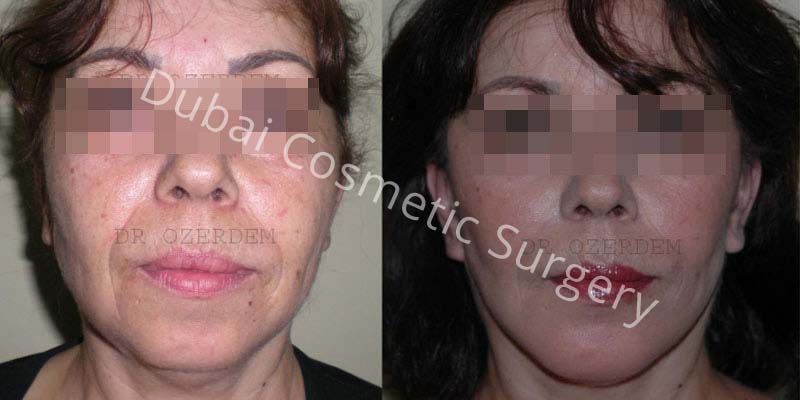
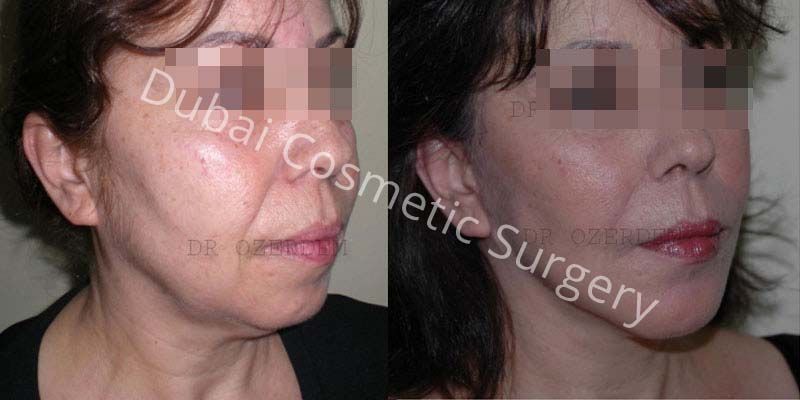
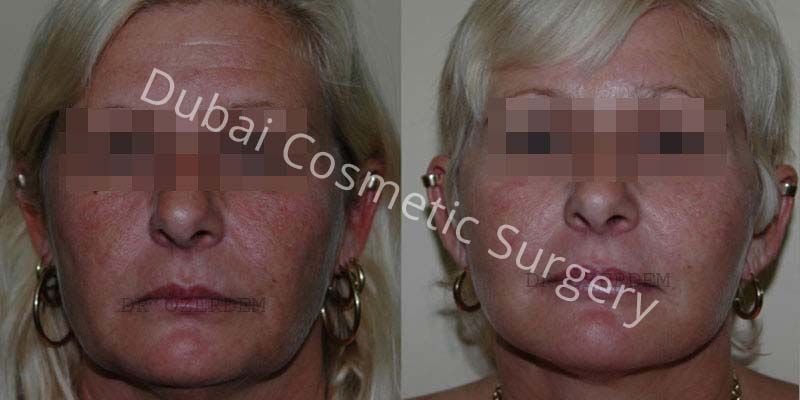

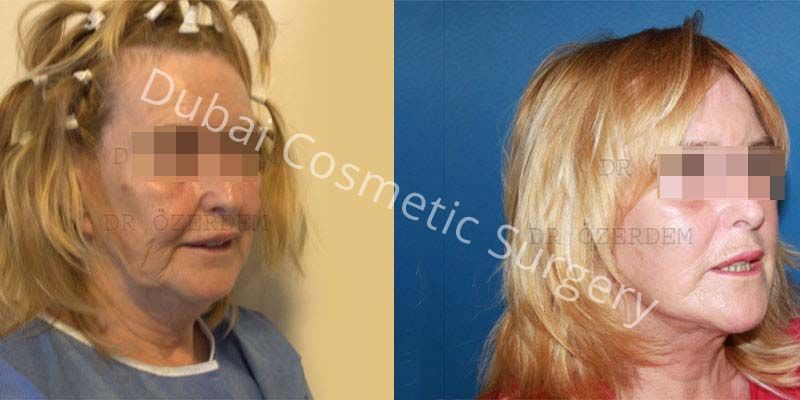
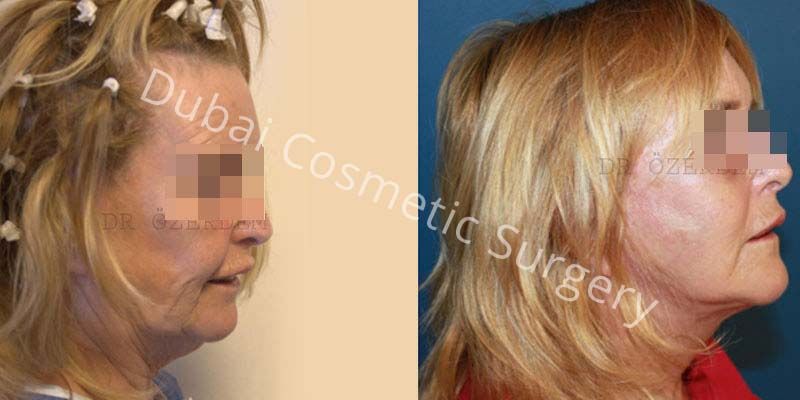
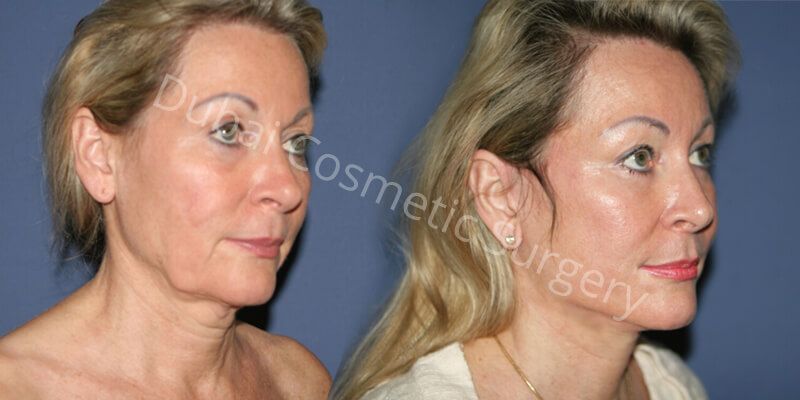

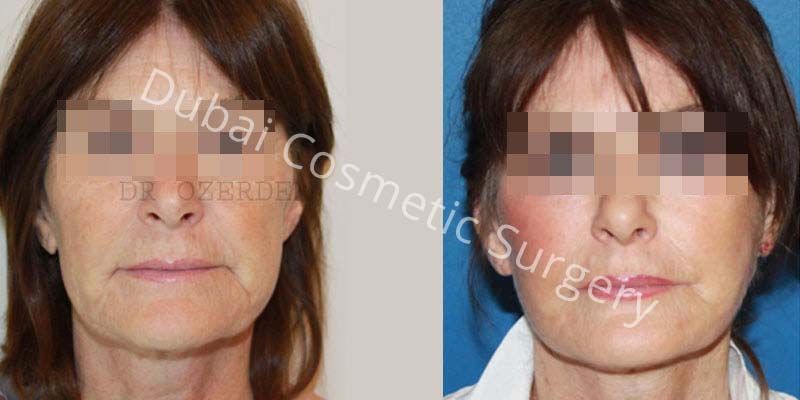
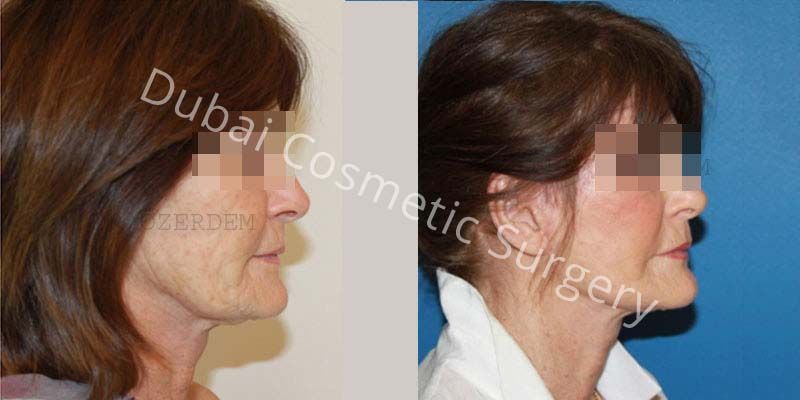
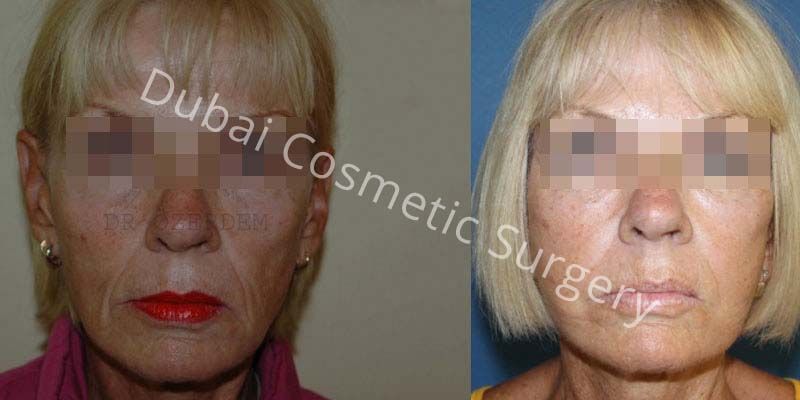
Cost of a Facelift
The starting cost of a facelift in Dubai is approximately AED 45,000. The final cost is determined based on several factors involved in the procedure, including:
- The type of facelift
- The complexity of the procedure, i.e., the depth and length of the incisions and the amount of fat and other tissues removed, sculpted, or redistributed
- Anesthesia fee
- The surgeon’s expertise
- The geographic location of the clinic or treatment facility
Is There A Non-Surgical Alternative To A Facelift?
Non-surgical facelift options are available and may be suitable alternatives to surgical facelifts for certain individuals. These techniques, which are non-invasive or minimally invasive, aim to reduce the signs of aging on the face and neck. These alternatives are ideal for individuals with fine lines, wrinkles, and mild to moderate skin laxity, who are not ready or suitable for surgical intervention.
Examples of non-surgical facelifts include the following:
- Botox injections
- Fat injections
- Dermal fillers
- Chemical peels
- Laser skin resurfacing
- Microneedling
- Fractional RF Microneedling
- Morpheus8
- HIFU (high-intensity focused ultrasound) therapy
Facelift – Rhytidectomy FAQs
Does facelift require anesthesia?
General anesthesia, commonly used in various plastic surgeries, induces a sleep-like state to ensure the patient does not feel pain during the procedure.
Are the results of facelift permanent?
The effects of a facelift are long-lasting, though not permanent. They can last for almost 10 years but not for life. This is because the facelift procedure can only reverse the signs of aging on your face. It cannot stop the aging process. Therefore, to retain the results you will have to lead a healthy lifestyle and maintain a balanced diet. You should avoid sun exposure to keep the firm and younger-looking facial skin for a long time.
What to expect after a facelift?
Soon after the surgery, dressings will be placed on your face along with a drainage tube that removes the excess blood and fluid. The tube is removed the next day and the dressing is changed.
Your surgeon will remove the dressings a few days after the procedure which are replaced with an elastic facial sling. The purpose of this sling is to provide support and facilitate healing.
The sutures are removed almost 10 days after the surgery. You will experience discomfort, pain, swelling and bruising but they will subside with time. Moreover, you will also experience scarring that will fade within a year.
Our Facelift Surgeons
Free Consultation
Remember, the whole point of facelift surgery is to make you look and feel younger, which leads to feeling better about yourself. Each patient who opts for a facelift treatment will receive a tailor-made procedure that is customized for them only. Visit our clinic today or fill out the form given below to book an appointment online and learn more about the procedure. We offer a free initial consultation to all patients who are interested in getting facelifts in Dubai from one of our cosmetic surgeons.
Fill in the form to get a consultation
100% Financing with 0% Interest
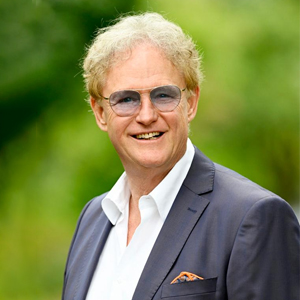


Comments are closed.